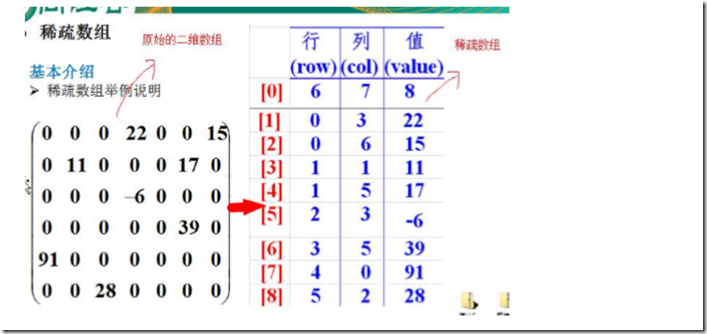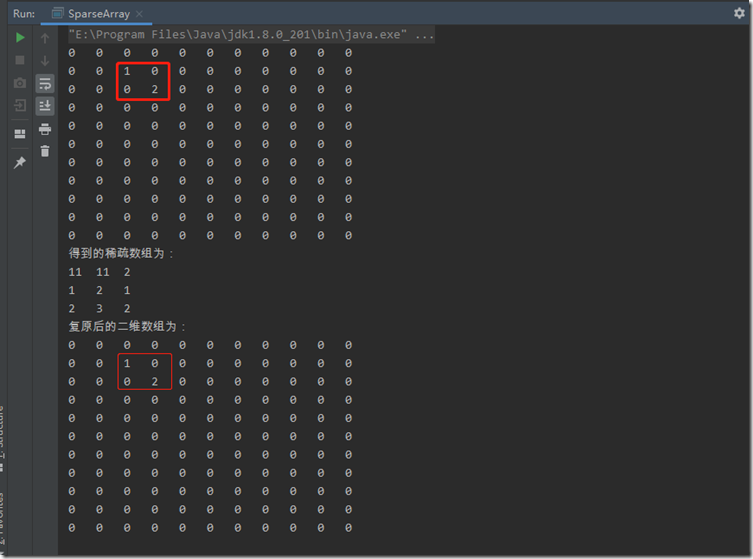1、简介
当一个数组中的大部分元素为0,或者为同一个值时,可以使用稀疏数组来保存该数组
稀疏数组的处理方法是:
1)记录该数组一共几行几列,有多少个不同的值
2)把具有不同值的元素的行列及值记录在一个小规模的数组中,从而缩减程序的规模
原理图:
2、稀疏数组的代码实现
public class SparseArray { public static void main(String[] args) { //创建一个原始的二维数组 11x11 //0: 表示没有棋子 1:表示黑子 2:表示白子 int chessArray1[][]= new int[11][11]; chessArray1[1][2] = 1; chessArray1[2][3] =2; //输出原始的二维数组 for(int i=0;i<chessArray1.length;i++){ for(int j=0;j<11;j++){ System.out.printf("%d ",chessArray1[i][j]); } System.out.println(); } //将二维数组转成稀疏数组 //1、遍历二维数组,得到非0的个数 int sum= 0; for(int i=0;i<chessArray1.length;i++){ for(int j=0;j<11;j++){ if(chessArray1[i][j]!=0){ sum++; } } } //2、创建对用的稀疏数组 int sparseArr[sum+1][3] int sparseArray[][] = new int[sum+1][3]; //3、给稀疏数组赋值 //3.1 给第一行赋值 sparseArray[0][0] = 11; sparseArray[0][1] = 11; sparseArray[0][2] = sum; //3.2 给剩余的其他行赋值 int count = 1; //记录稀疏数组的行号 for(int i=0;i<chessArray1.length;i++){ for(int j=0;j<11;j++){ if(chessArray1[i][j]!=0){ sparseArray[count][0]=i; sparseArray[count][1]=j; sparseArray[count][2]=chessArray1[i][j]; count++; } } } //输出稀疏数组 System.out.println("得到的稀疏数组为:"); for(int i=0;i<sparseArray.length;i++){ for(int j=0;j<3;j++){ System.out.printf("%d ",sparseArray[i][j]); } System.out.println(); } //将稀疏数组恢复成原始的二位数组 //1、先读取稀疏数组的第一行,根据第一行的数据,创建原始的二维数组 int[][] chessArray2 =new int[sparseArray[0][0]][sparseArray[0][1]]; //2、将稀疏数组的后几行数据,赋值给原来的二维数组 for(int i=1;i<sparseArray.length;i++){ chessArray2[sparseArray[i][0]][sparseArray[i][1]]=sparseArray[i][2]; } //输出复原后的二维数组 System.out.println("复原后的二维数组为:"); for(int i=0;i<chessArray2.length;i++){ for(int j=0;j<11;j++){ System.out.printf("%d ",chessArray2[i][j]); } System.out.println(); } } }
3、课后练习
public class ArrayStore { public static void main(String[] args) throws IOException, IOException { //创建一个原始的二维数组 11x11 //0: 表示没有棋子 1:表示黑子 2:表示白子 int chessArray1[][]= new int[11][11]; chessArray1[1][2] = 1; chessArray1[2][3] =2; //输出原始的二维数组 for(int i=0;i<chessArray1.length;i++){ for(int j=0;j<11;j++){ System.out.printf("%d ",chessArray1[i][j]); } System.out.println(); } //将二维数组转成稀疏数组 //1、遍历二维数组,得到非0的个数 int sum= 0; for(int i=0;i<chessArray1.length;i++){ for(int j=0;j<11;j++){ if(chessArray1[i][j]!=0){ sum++; } } } //2、创建对用的稀疏数组 int sparseArr[sum+1][3] int sparseArray[][] = new int[sum+1][3]; //3、给稀疏数组赋值 //3.1 给第一行赋值 sparseArray[0][0] = 11; sparseArray[0][1] = 11; sparseArray[0][2] = sum; //3.2 给剩余的其他行赋值 int count = 1; //记录稀疏数组的行号 for(int i=0;i<chessArray1.length;i++){ for(int j=0;j<11;j++){ if(chessArray1[i][j]!=0){ sparseArray[count][0]=i; sparseArray[count][1]=j; sparseArray[count][2]=chessArray1[i][j]; count++; } } } //输出稀疏数组 System.out.println("得到的稀疏数组为:"); for(int i=0;i<sparseArray.length;i++){ for(int j=0;j<3;j++){ System.out.printf("%d ",sparseArray[i][j]); } System.out.println(); } //文件的路径 String str = "d:/sparse.txt"; File file = new File(str); //如果磁盘中该文件不存在,则创建该文件 if (!file.exists()){ file.createNewFile(); } //创建字符写入流对象 FileWriter fileWriter = new FileWriter(str); for (int i = 0; i < sparseArray.length; i++) { for (int j = 0; j < sparseArray[i].length; j++) { //写入每个字符 fileWriter.write(sparseArray[i][j]); } } //关闭写入流 fileWriter.close(); System.out.println("写入完毕"); //创建新的数组,来接收读取的数据 int [][] sparseArr2 = new int[sum+1][3]; FileReader fileReader = new FileReader(str); for (int i = 0; i < sparseArr2.length; i++) { for (int j = 0; j < sparseArray[i].length; j++) { //把读取的数据设置到数组中 sparseArr2[i][j] = fileReader.read(); } } System.out.println("从文件读出的稀疏数组为:"); for(int i=0;i<sparseArr2.length;i++){ for(int j=0;j<3;j++){ System.out.printf("%d ",sparseArr2[i][j]); } System.out.println(); } //关闭读取流 fileReader.close(); } }



